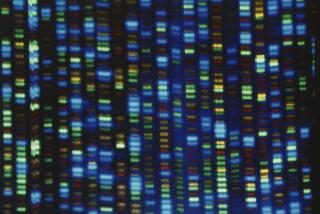Disease Hunters Get a New Genetic Map
- Share via
The search for the causes of complex genetic diseases received a major boost today with the publication of the first map of human genetic variations, the subtle genetic changes that make each of us different from our neighbors.
Humans worldwide share 99.9% of their genetic blueprint. But it is that 0.1% difference that makes people unique, and which is the root of the genetic mischief that causes diseases such as diabetes, asthma, hypertension, cancer and others.
Previously, researchers looking for disease-causing genes have had to sift through the 3 billion individual chemical letters, called nucleotides, that comprise the human blueprint. But it has become clear that each of the individual changes, called single nucleotide polymorphisms, or SNPs, is linked to a large block of DNA, called a haplotype, that is generally inherited intact.
By focusing on haplotypes, researchers are able to reduce the number of sites that must be searched to a more manageable 1 million, speeding up the hunt for genetic change.
An international consortium of more than 200 researchers from six countries reported Wednesday at an American Society of Human Genetics meeting in Salt Lake City that it had completed a haplotype map, called a HapMap, using genetic information from individuals from around the world. The map will be published today in the journal Nature.
“The HapMap is a phenomenal tool that is making possible research that was impractical, if not unimaginable, only a few years ago,” said Dr. Yusuke Nakamura of the University of Tokyo’s Human Genome Center. “It offers the scientific community an enormous savings, reducing the expense of searching the genome for hereditary factors in common disease by a factor of 10 to 20.”
Identifying the genes that produce susceptibility to diseases such as diabetes will lead to new techniques for diagnosis, treatment and, eventually, prevention, experts said.
Already, researchers using preliminary data from the three-year, $138-million project have identified a gene that plays a key role in age-related macular degeneration, the leading cause of blindness among the elderly.
Teams in Japan, Canada and Britain have started screening the haplotypes of thousands of individuals with a variety of diseases, comparing them with healthy control groups to identify genetic susceptibility not only to chronic diseases such as hypertension and bipolar disorder but to infectious diseases such as tuberculosis and malaria.
“We will see an outpouring of discovery in the next two to three years,” said Dr. Francis S. Collins, director of the National Human Genome Research Institute.
The team used DNA from blood samples collected from 269 people from around the world, including Yoruba from Nigeria, Japanese from Tokyo, Han Chinese from Beijing and Utah residents with ancestry from Northern and Western Europe.
Researchers will soon expand the database, using DNA samples from two other groups in Africa and five from the rest of the world, said Charles N. Rotimi of Howard University.
In addition to clues about the causes of diseases, the HapMap gives information about the evolution of humans and how ethnic groups differ from each other, said Dr. David Altshuler of the Broad Institute at Harvard and MIT. Or more precisely, he said, how little they differ.
Across the 1 million haplotypes studied, the team found five that always differed between the Yoruba samples and those from Japan and China. They found 11 between the Yoruba and those from Utah, and 21 between the Utah samples and the Japanese and Chinese samples.
The differences may be due less to ethnicity than to geographic location, Collins said. Two of the first differences identified in the project were the already well-known Duffy blood group, which controls response to malaria, and the lactase gene, which influences the ability to digest milk products.
Researchers have nearly finished a second phase of the HapMap that breaks the initial 1 million haplotypes into 2.8 million, which will help the teams focus on disease genes once their general location has been determined.






